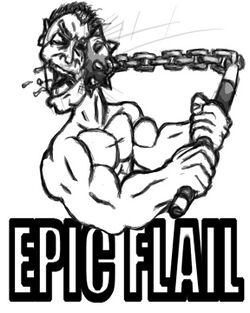Mace

Long before Australopithecus strode the savannah, one of our distant ancestors figured out that hitting something with a good solid stick was easier on the knuckles and harder on the target. Thus was born the club. Fast forward a few million years to a camp of more advanced, but still primitive humans. One of them figures out that you could get an even better club by attaching a rock to the end of it to hit the target hit even harder. Thus was born the Mace, like the spear one of the oldest weapons.
Maces in Warfare
The first thing about a mace is that, well, a mace is a stick with a hard bit on the end that you hit your enemy with. It's about as straightforward to use as you can get. Even more so than an axe or spear. At the same time, basic maces are even easier to make than spears. Attach a stone to solid stick, or hammer some metal spikes or a metal ring around the end. Like spears, they had a bargain basement quality for equipping militia with cheap backup weapons. Even so, more complex maces made entirely of metal were employed towards the end of the middle ages (more on this latter).
Unlike bladed weapons, maces did damage by blunt force trauma. They did not cleave apart or poke big holes into tissue and bone. Rather they shattered bones and pulverized organs. This has some advantages as their blows would often send force through ridged armor, though it was less effective against armor with padding behind it. Maces came in both spiked and non spiked varieties. Spiked maces had some (if not much) ability to penetrate armor and flesh. For this reason, once plate armor became common maces became one of the go to weapons used by knights for use in close quarters against other knights.
That said, a maces' blow while more likely to do some damage if they hit home were less likely to deliver a killing blow than a sword or axe strike and to do damage an mace strike needs to be moving at high speed with room to move like this. However, with a mace being a primarily kinetic weapon, a blow to the head is extremely dangerous, and has a fair chance of outright snapping the neck, helm or no. These sorts of maces also had to be more heavily built than swords, which meant that a mace could not have the same reach. Like axes, you needed a good swing to land a heavy blow.
Flails

Eventually, some starry-eyed young blacksmith had the clever idea of separating the handle of the mace and one-or-more heads before stringing them together with a length of hardened chain. And thus was born the flail, the mace's younger, sexier brother.
Flails pose many advantages over maces. The length of chain serves to add what amounts to a few extra feet of windup to the force of every blow, helping to counter some of the mace's space problems, and also gives the normally-short ranged weapon a little extra reach. Furthermore, due to the flexibility of the chain, a flail could circumvent certain forms of protection, striking blows around shields and parries to crash into secondary targets, or wrap around other weapons to disarm an opponent and open them up for a lethal follow-through. They weren't even that much harder to make than regular maces, though the addition of chain links did add significantly to the construction time.
However, all of these fun tricks were offset by a single, gigantic, unbelievable disadvantage that helped ensure that the mace remained common while the flail was stuck as a specialized elite weapon: training time. You think a sword takes a lot of work to use without being a danger to yourself and others? Flails were extremely unwieldy to handle and easy to lose in a fight, and that's before factoring in the problems of dealing concussive force rather than cutting or piercing an opponent that they share with maces. They had their place, but that place was primarily in the hands of a highly-trained knight slugging it out with another knight in full plate armor, not with a dude fumbling for a backup weapon because he couldn't use a spear properly.